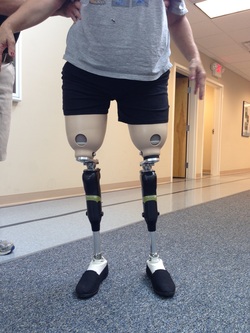Amputation is the process of removal of a limb or a part of the body like leg, hand, too or foot that has deformed by the surgical methods. Amputation of the leg either below or above the knee is the most common surgery that people undergo.
Reasons for Amputation?
There are many reasons for getting an amputation done, most common of it being improper blood circulation because of either narrowing or damage in the arteries known as peripheral arterial disease. When any part of the body encounters an improper or poor flow of blood, the cells that need oxygen does not receive an adequate amount of oxygen required. This, in turn, reduces the nutrient content required that they receive from the bloodstream. As the process repeats, with time, the affected part, tissue or nerve begins to die and gets infected.
Other reasons may include:
- The cancerous tumor in the muscle, limb or bone.
- Infection that has been for a long time and is getting serious despite the continuous medication and treatments.
- Neuroma, i.e., the thickening of nerve tissue
- Frostbite
- Severe Injury
Procedure of Amputation:
- A hospital stay for five to fourteen days is recommended after an amputation surgery. The number of days that your doctor may ask you to stay in the hospital depends upon the surgery and the treatment required. The procedure may vary, depending on the limb or the type of amputation needed.
- General anesthesia or spinal anesthesia are two basic types of anesthesia used during the surgery. The spinal anesthesia numbs the entire portion of the body below the knee, and the local anesthesia makes the patient conscious for a couple of hours.
- The surgeon removes the tissues that have been damaged and leaves the tissue that are healthy during an amputation surgery.
There are several methods through which the surgeon can decide how and where to cut the tissue to extract. They are:
- Look for the areas that have a reddish skin
- Look if the skin where the surgeon is planning to cut is sensitive to any touch sensations
- Temperature comparison of the defective limb with the healthy limb
- Checking the pulse close to the part where the surgeon is going to put a cut.
During the surgery, the surgeon will:
- Take off the damaged tissues and crushed bones if any
- Smoothen the areas of the bones that are uneven
- Seal the nerves and the blood vessels
- Shape the muscles so that the end of the limb can accommodate an artificial limb also known as a prosthetic limb that will be attached to it.
- The surgeon can either sew the wound or leave it open for few days depending upon the need of further removal of the dead tissues. The doctors then cover the wound with a sterile dressing and place a stocking to cover the tubes and bandages.
An amputation surgery may take some time to recover that depends on the type of the procedure used to perform the surgery. Consult your doctor if you sense pain in the amputated limb.